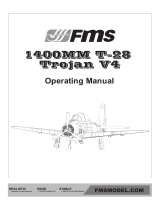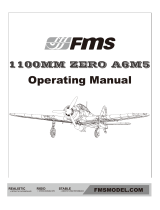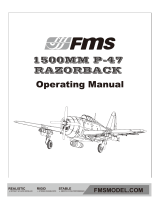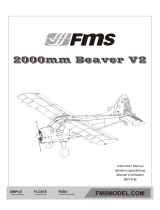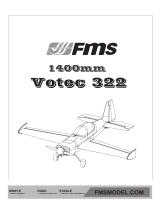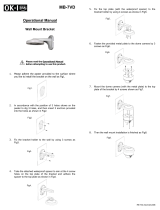Page is loading ...

1400MM P-40B
1400
1192 46.9
55.1
2500g 88.2
74.2
33.7 522.3
0.17
6
Please visit both our facebook fan page and our
homepage for updated product information
heep://www.facebook.com/FMSmodel
www.fmsmodel.com

2
Safety
Lithium Polymer (Li-Po) Battery Warning
CAUTION: Always follow the manufacturer’s instructions for safe use and disposal of batteries. Fire, property
damage, or serious injury can result from the mishandling of Li-Po batteries.
By handing, charging or using a Li-Po Battery you assume all risks associated with lithium batteries.
If at any time the batteries begin to swell, or balloon, discontinue use immediately!
Always store the batteries at room temperature in a dry area to extend the life of the battery, Always transport
Never use a Ni-Mh Charger to charger Li-Po Batteries. Failure to charge the battery with a Li-Po compatible charger
may cause fire resulting in personal injury and property damage.
Never discharge Li-Po Cells below 3V.
Never leave charging batteries unattended.
Never charge damaged batteries.
Charging the Flight Battery Warning
Use a battery charger that is designed to safely charge the Li-Po Battery. Read the charger instructions care
fully before use. When charging the battery, make certain the battery is on a heat resistant surface. It is also highly
recommended to place the Li-Po Battery inside a fire resistant charging bag readily available at hobby shops or
online.
or temporarily store the battery in a temperature range of 40-120F. Do not tore the battery or model in a car or in
direct sunlight. If stored in a hot car, the battery can be damaged or even catch fire.
Safety Precautions and Warnings
WARNING
WARNING: Read the ENTIRE instruction manual to become familiar with the features of the product before operating.
Failure to operate the product correctly can result in damage to the product. personal property and cause serious
injury.
This is a sophisticated hobby product and NOT a toy. It must be operated with caution and common sense and
requires in injury or damage to the product or other property. This product is not intended for use by children without
direct adult supervision.
This manual contains instructions for safety operation and maintenance. It is essential to read and follow all the
instructions and warnings in the manual prior to assembly, setup or use, in order to operate and avoid damage or
serious injury.
As the user of this product. you are solely responsible for operating in a manner that does not endanger yourself and
others or result in damage to the product or the property of others. This model is controlled by a radio signal subject
to interference from many sources outside your control. This interference can cause momentary loss of control so it
is advisable to always keep a safe distance in all directions around your model, as this margin will help avoid collisions
or injury.
Age Recommendation: Not for children under 14 years. This is not a toy .
·Never operate your model with low transmitter batteries.
·Always operate your model in an open area away from cars, Traffic or people.
·Avoid operating your model in the street where injury or damage can occur.
·Never operate the model in the street or in populated areas for any reason.
·Carefully follow the directions and warnings for this and any optional support equipment ( chargers. Rechargeable
battery packs, etc. ) you use.
·Keep all chemicals, small parts and anything electrical out of the reach of children.
·Moisture causes damage to electronics. Avoid water exposure to all equipment not specifically designed and
protected for this purpose.
·Never lick or any place of your model in your mouth as it could cause serious injury or even death.

A: Main wing
B: Main fuselage
C: Propeller
D: Sipnner
E: Main wing tube
F: Horizontal Stabilizer mounting screws (PM3.0*32/40mm)
3
Introductions..................................................................................................................................................3
Contents of Kit...............................................................................................................................................3
Assemble the plane.......................................................................................................................................4
Install the battery............................................................................................................................................6
Get your model ready to fly............................................................................................................................7
The transmitter and model setup...................................................................................................................8
Check the control throws...............................................................................................................................9
Check the motor rotating direction.................................................................................................................9
Control Horn and Servo Arm Settings.............................................................................................................9
Install the propeller and spinner...................................................................................................................10
Check the C.G.(Center of Gravity)................................................................................................................10
Before flying the model ................................................................................................................................11
Flying course.................................................................................................................................................12
Troubleshooting............................................................................................................................................13
Spare parts list content................................................................................................................................14
ESC instruction............................................................................................................................................15
Table of Contents
If you are a fan of military, you’ll understand the glorious history of the Flying Tiger. The Flying Tiger played
an important role and had a brilliant record in China during WWII. To pay homage to this classic warbird,
FMS has revived it AGAIN after numerous further studies and tests.
In the RC model world, the FMS P-40 shows extraordinary talents. The stable flying performance could rival
any of the other warbirds. The new high-magnification foaming greatly lowers the flying weight. The scaled
appearance allows it to be a static exhibit. The metal shock-absorbing landing gear set could undertake
severe impact and lead to a smooth landing. The separating flaps, the front and rear retract, the plastic
decorative parts fully reappear on this classic warbird. Newlydesigned ball link control hardware replaces
traditional clevises. The additional servo box makes it more simpler to assemble and take apart. The 17g
metal gear servo, 70A ESC, and 4258 motor ensure the superior quality of flight.
Introductions
Before assembly, please inspect the contents of the kit. The photo below details the contents of the kit and
labels. If any parts are missing or defective, please indentify the name or part number (refer to the spare
parts list near the end of the manual) then contact your local shop or email us: [email protected]
Contents of Kit
A.
B.
G.
C. E.
F.D.
G: Horizontal stabilizer
H: The main wing screw (PM3.0*50mm)
I: Rudder and rudder screwPA2.6*15mm
J: Wing Bolt
K: Oil Tank and screwPA2.6*15mm
H.
I.
J. K.

4
fig2
fig3
fig1
1. Unpack the parts bag for aileron, which includes screws and linage rods. Install the linkage rods as shown
in Figure 1. See page 9 for close up of the installation and suggestions for the linkage rod and servo arm
hook up. Do the same on Flap assemblies as shown in Figure 2 and 3.
2.
Slide the wing tube into the wing holes. Ensure the the connector wires pass through the hole to the top
side of the wing. Secure the wing together by installing two brackets where the two wing halves join as
shown. Assemble the oil tank using the screw PA2.6*15mm as shown in Figure6.
Assemble the plane
fig4

5
fig8
fig7
fig6
3.
4.
Unpack the elevator parts bag and assemble using screw PM3.0*32mm and PM3.0*40mm, attach the
linkage on the control horn.
PA2.6*15mm
PM3.0*32mm
PM3.0*40mm
PM3.0*50mm
fig5
fig9
Turn over the fuselage so the bottom faces up and feed the connector wires thorough the hole in the
fuselage. Secure the wing in place using 4 wing screws.

fig11
6
Install the battery
fig13
Gear
Gear
Flap
1. Apply the hook tape to the cable end of the battery (fig12).
2.
Slide the battery into the battery hatch with the power supply cable toward the rear end of the plane and the
hook tape facing the bottom of the battery hatch. Note: You may need to relocate the battery position to
achieve the correct CG for your model.
PWA2.6*15mm
Flap
6
6
fig10
a. Lower the throttle and throttle trim to the lowest setting. Power on the Transmitter, then wait 5 seconds.
b. Connect the battery to ESC and let the rear landing gear down using your transmitter and receiver.
c. Assemble the Vertical Tail to the fuselage using the screw PWA 2.6*15mm.
fig12

7
Get your model ready to fly
Important ESC and model information
1.
The ESC included with the model has a safe start. If the motor battery is connected to the ESC and the
throttle stick is not in the low throttle or position, the motor will not start until the throttle stick is moved to the
low throttle or off position. Once the throttle stick is moved to the low throttle or off position, the motor will
emit a series of beeps. Several beeps with the same tune means the ESC has detected the cells of the
battery. The count of the beeps equals the cells of the battery. The motor is now armed and will start when
the throttle is moved.
2.
The motor and ESC come pre-connected and the motor rotation should be correct. If for any reason the
motor is rotating in the wrong direction, simply reverse two of the three motor wires to change the direction
of rotation.
3. The motor has an optional brake setting. The ESC comes with brake switched off and we recommend that
the model be flown with the brake off. However, the brake could be accidentally switched on if the motor
battery is connected to the ESC while the throttle stick is set at full throttle. To switch the brake off, move the
throttle stick to full throttle and plug in the motor battery. The
motor will beep one time. Move the throttle stick to low throttle or the off position. The motor is ready to run
and the brake will be switched off.
4. Battery Selection and Installation. We recommend the 14.8V 3300mAh 35C Li-Po battery. If using another
battery, the battery must be at least a 14.8V 3300mAh 35C battery. Your battery should be approximately the
same capacity, dimension and weight as the 14.8V 3300mAh 35C Li-Po battery to fit the fuselage without
changing the center of gravity significantly.
1. Apply the hook tape to the cable end of the battery (fig12).
2. Slide the battery into the battery hatch with the power supply cable toward the rear end of the plane and the
hook tape facing the bottom of the battery hatch. Note: You may need to relocate the battery position to
achieve the correct CG for your model.
CH5B
CH5C
CH1
CH6
LED
Plug for rudder servo
Plug for elevator servo
Plug for wing serial plugs
Plug for landing gear
bay doors
Plug for worm-gear
retract servo
Serial plug for the right wingSerial plug for the left wing
CH5
CH2
CH4
CH5C
CH5B
CH4
CH2
CH1
CH6
CH5B
CH5C
CH1
CH6
LED
Connectors Diagram

8
The transmitter and model setup
Before getting started, bind your receiver with your transmitter. Please refer to your Transmitter Manual for
proper operation
CAUTION: To prevent personal injury, DO NOT install the propeller assembly onto the motor shaft while
testing the control surfaces. DO NOT arm the ESC and do not turn on the transmitter until the Transmitter
Manual instructs you to do so.
Tips: Make sure all control sticks on your radio are in the neutral position (rudder, elevator, ailerons) and the
throttle in the OFF position. Make sure both ailerons move up and down (travel) the same amount. This model
tracks well when the left and right ailerons travel the same amount in response to the control stick.
1. Move the controls on the transmitter to make sure aircraft control surface move correctly. See diagrams
below.

9
The table shows the factory settings for the control horns and servo arms. Fly the aircraft at the factory
settings before making changes.
After flying, you may choose to adjust the linkage positions for the desired control response.
Control Horn and Servo Arm Settings
More control throw
Less control throw
Elevator
Rudder
Ailerons
Horns Arms
Check the control throws
Check the motor rotating direction
The motor should rotate clockwise when viewing the plane from the rear.
The suggested control throw setting for FMS MODEL are as follows (dual rate setting):
Tips: At first flight, fly the model in low rate. The first time you use high rates, be sure to fly at low
to medium speeds. High rate as listed are only for EXTREME maneuvering.
24
23
35
13
15
20

10
b
g
f
e
c
d
a
Assemble the spinner and propeller as shown below.
Install the propeller and spinner
Check the C.G.(Center of Gravity)
When balancing your model, adjust the motor battery as necessary so the model is level or slightly nose down.
This is the correct balance point for your model. After the first flights, the CG position can be adjusted for your
personal preference.
1. The recommended Center of Gravity (CG) location for your model is (50-55mm) forward from the leading
edge of the main wing (as shown) with the battery pack installed. Mark the location of the CG on top of the
wing.
2. When balancing your model, support the plane at the marks made on the bottom of the main wing with your
fingers or a commercially available balancing stand. This is the correct balance point for your model. Make sure
the model is assembled and ready for flight before balancing.
50-55mm

11
Before flying the model
Find a suitable flying site
Perform the range check for your plane
Monitor your flight time
Find a flying site clear of buildings, trees, power lines and other obstructions. Until you know how much area
will be required and have mastered flying your plane in confined spaces, choose a site which is at least the
size of two to three football fields - a flying field specifically for R/C planes is best. Never fly near people -
especially children who can wander unpredictably.
As a precaution, an operational ground rage test should be performed before the first flight each time you go
out. Performing a rang test is a good way to detect problems that could cause loss of control such as low
batteries, defective or damaged radio components, or radio interference. This usually requires an assistant
and should be done at the actual flying site you will be using.
First turn on the transmitter, then install a fully - charged battery into the fuselage. Connect the battery and
install the hatch.
Remember, use care not to bump the throttle stick. otherwise, the propeller/fan will turn and possibly cause
damage or injury.
Note: Please refer to your Transmitter Manual that came with your radio control system to perform a ground
range check. If the controls are not working correctly or if anything seems wrong, do not fly the model until
you correct the problem. Make certain all the servo wires are securely connected to the receiver and the
transmitter batteries have a good connection.
Monitor and limit your flight time using a timer (such as on a wristwatch or in your transmitter if available).
When the batteries are getting low you will usually notice a performance drop before the ESC cuts off motor
power, so when the plane starts flying slower you should land. Often (but not always) power can be briefly
restored after the motor cuts off by holding the throttle stick all the way down for a few seconds.
To avoid an unexpected dead-stick landing on your first flight, set your timer to a conservative 4 minutes.
When your alarm sounds you should land right away.

12
Flying course
Flying
Take off
While applying power, slowly steer to keep the model straight. the model should accelerate quickly. As the
model gains flight speed you will want to climb at a steady and even rate. P40 will climb out at a nice angle
of attack (AOA).
Always choose a wide-open space for flying your plane. It is ideal for you to fly at a sanctioned flying field. If
you are not flying at an approved site always avoid flying near houses, trees, wires and buildings. You should
also be careful to avoid flying in areas, where there are many people, such as busy parks, schoolyards, or
soccer field. Consult laws and ordinances before choosing a location to fly your aircraft. After takeoff, gain
some altitude. Climb to a aspects of flight does not make sense, including high speed passes, inverted flight,
loops, and point rolls.
Land the model when you hear the motor pulsing (LVC) or if you notice a reduction in power. If using a transmitter
with a timer, set the timer so you have enough flight time to make several landing approaches.
Recharge the battery and repair the model as needed .The model’s three point landing gear allows the model
to land on hard surfaces. Align model directly into the wind and fly down to the ground. Fly the airplane down
to the ground using 1/4-1/3 throttle to keep enough energy for proper flare. Before the model touches done,
always fully decrease the throttle to avoid damaging the propeller or other components. The key to a great
landing is to manage the power and elevator all the way to the ground and set down lightly on the main landing
gear. After a few flights you will find the model can be set down lightly on the mains and you can hold the nose
wheel off balancing the model on the mains until it slows and gently settles the nose.
Repairs to the foam should be made with foam safe adhesives such as hot glue, foam safe CA, and 5min
epoxy. When parts are not repairable, see the Spare Parts List for ordering by item number.
Always check to make sure all screws on the aircraft are tightened. Pay special attention to make sure the
spinner is firmly in place before every flight.
Maintenance
Landing

13
Troubleshooting

14
FMSPK101 Fuselage
FMSPK102 Main Wing Set
FMSPK103 Vertical Stabilizer
FMSPK104 Horizontial Stabilizer
FMSPK105 Cockpit
FMSPK106 Oil Tank
FMSPK107 Front Landing Gear Door
FMSPK108 Rear Landing Gear Door
FMSPK109 Air Speed Head,Gun Set And Gunsight
FMSPK110 Wing Bolt Plate
FMSPK111 Spinner
FMSPK112 Main Landing Gear Strut
FMSPK113 Main Landing Gear System
FMSPK114 Rear Landing Gear System
FMSPK115 Linkage Rod
FMSPK116 Screw Set
FMSPK117 Decal Sheet
FMSPK118 Tire Set
FMSPK119 Pipe
FMSPK120 Battery Tray
FMSPK121 Exhaust Pipe
FMSPK122 LED
FMSPK123 Lamp Cover
FMSPROP012 Propeller
FMSBM003 Motor Board
FMSDJ014 Motor Mount
FMSDZ009 Motor Shaft
FMSCON001 Multi Connector System
FMS-Retract 006 FMS Retract SET
FMS-4258-KV650 Motor
FMS-ESC-70A200 ESC
FMSSER9GMGD-54DEG FMS 9g digital metal gear servo 54 DEGREE
FMSSER17MGD 17g digital metal gear servo
Visit our website to see photos of this product: www.fmsmodel.com
Spare parts list content

15
ESC instruction

/
